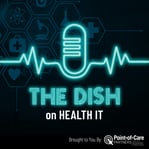HIMSS25 Recap: Perspectives & Insights
In this special HIMSS25 recap episode of The Dish on Health IT, host Tony Schueth, CEO of Point-of-Care Partners (POCP), is joined by co-hosts Brian Bamberger, POCP’s Life Sciences Lead, and Vanessa Candelora, Senior Consultant and Program Manager of the HL7 Gravity Project. Together, they break down the biggest themes from the conference, covering interoperability, artificial intelligence (AI), FHIR adoption, and the growing focus on improving data quality in healthcare innovation.
HIMSS25 once again proved to be a crucial gathering of healthcare leaders, vendors, and policymakers, drawing nearly 28,000 attendees. Vanessa notes the continued focus on interoperability and trust, with a clear divide between experienced stakeholders refining their strategies and newcomers trying to grasp the fundamentals of FHIR. Brian, a HIMSS veteran, points out that first-time attendees often struggle with the complexity of both the conference itself and the discussions around health IT’s latest advancements, particularly AI and its real-world applications.
To add perspectives from the conference floor, Tony introduces a series of interviews with HIMSS25 attendees and industry leaders, including Anna Taylor, Associate Vice President, Population Health and Value-Based Care of MultiCare, Erin Weber, Chief Policy & Research Officer, CAQH, Mariann Yeager, CEO, The Sequoia Project, Matthew Holt, Founder/Writer of The Health Care Blog, and Lynne Nowak, Chief Data and Analytics Officer, Surescripts. Each interview provides insights into the real-world implementation of interoperability and FHIR, the evolving use of AI, and how data privacy and governance are shaping health IT strategy.
FHIR adoption was one of the topics covered in the interviews. Some, like Mariann Yeager and Erin Weber, expressed optimism about FHIR’s expanding role in clinical data exchange, while others, such as Anna Taylor, highlighted persistent scalability challenges and limited adoption for administrative functions like prior authorization. Matthew Holt offered a broader view on data exchange, arguing that while data mobility has improved, the real challenge is how organizations use and integrate that information. Vanessa underscores that while FHIR is gaining traction globally, large-scale implementation remains a work in progress. The panel agrees that translating theoretical frameworks into real-world adoption is the next crucial step.
AI was another dominant topic, with a mix of enthusiasm and skepticism surrounding its potential. The HIMSS interviewees discuss AI’s growing role in streamlining administrative workflows, summarizing patient records, and enabling ambient listening for clinical documentation. However, as Brian bluntly puts it, the “magic” of AI is still far from reality—many tools promise seamless EHR integration but cannot write back into clinical systems, requiring manual intervention. Lynne Nowak and others emphasized that AI’s effectiveness is directly tied to data quality—bad inputs will only lead to bad outputs. The consensus? AI has real potential to enhance workflows but cannot replace clinicians, and health IT leaders must focus on governance, usability, and ensuring AI supports, rather than replaces, human decision-making.
As the conversation wraps up, Vanessa highlights the critical role of policy and strategic innovation in shaping the next wave of health IT progress. With new regulatory shifts and uncertainty around TEFCA, organizations must stay agile while ensuring that patient privacy, data integrity, and consent management remain top priorities. Brian brings the discussion back to life sciences, stressing the importance of leveraging patient insights and real-world data to drive treatment adherence and improve outcomes.
HIMSS25 reinforced that while FHIR, AI, and interoperability remain hot topics, the industry is now at a critical inflection point—shifting from theory to execution. Organizations must filter out hype, focus on data quality, and build scalable solutions that improve both clinical and administrative functions.
For those who couldn’t attend HIMSS25 or want a deeper dive into what’s next for health IT, this episode provides a comprehensive breakdown of the major takeaways. Subscribe to The Dish on Health IT on Apple Podcasts, Spotify, or your preferred platform. The podcast is also available on HealthcareNOW Radio. Full video versions are also available on POCP’s YouTube channel. As always, health IT is a dish best served hot.





